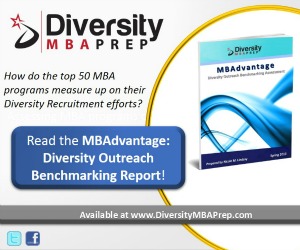Knocking Down the Door to Business School
Imagine you are standing in front of a wooden door. You think you might want to go through it, but the door seems pretty impossible to open. The door is heavy with only a small doorknob that doesn’t seem nearly durable enough to swing open the door. In fact, you think the door may be locked. So what should you do next? Do you politely knock on the door to see if someone on the other opens it? Or maybe you jiggle the handle to see if the door is unlocked? Or maybe you are the person who forcibly tries to open the door, finding some tools to take it off the hinges if necessary? And what if earlier when you walked down the hall toward the door, there were signs that said you couldn’t go through the door or that what was on the other side of the door wasn’t for you or that you were incapable of opening the door?
The door that I describe above is the door to business school that all candidates must go through if they want an MBA. And too many women and minorities are not making it through. I published the MBAdvantage: Diversity Outreach Benchmarking Report in late April with the goal of knocking down the door – not, as some would suggest, so anyone can walk through it, because it is a privilege to go to a top business school and it must be earned. But knock the door down so that the very best candidates can see through the doorway and determine whether it’s a path that they want to take. I want them to see through the doorway and know that if they are interested and capable, they have to opportunity to compete to go through the door. And when the door is open, all candidates, regardless of background, can see the opportunities, see the challenges, see that there are others that look like them or have similar interests as them and they can make an informed decision about competing get to the other side.
My report is centered on business schools doing more to open or remove the door to their MBA programs that for a number of reasons have deterred women and minorities from even applying. With that said, the responsibility to get more women and minorities into top MBA program does not solely rest with business schools. Candidates must determine that if they like what is on the other side of the door that they are going to aggressively go after getting across the threshold despite real or perceived obstacles in their way.
As people have learned about my report there has been a little criticism (some of which would be alleviated if they actually read the report, but such is life). A few people have suggested that it’s silly to focus on ethnicity and gender as it goes against achieving “real” diversity in business school. At a basic level this is true, and as I described in the report, I have very broad view of diversity and its potential to educate future leaders within MBA programs. Ethnicity and gender are just two of so many factors that create a robust educational experience. But by not having women and minorities represented in sufficient numbers, business schools are shortchanging every student who sits in that MBA classroom – both in limiting different perspectives and in reducing the caliber of the student body. Quite simply, if more women than men have graduated from college in the last twenty years and women tended to do better while there, doesn’t it seem a little off that we think the very best of business school has only 32% women? If we are ever going to reach our aspiration of equal access, then we must knock down the door and allow everyone to compete against the very best future business leaders.
Finally, I fully acknowledge here and in the report that by framing this project around women and under-represented minorities, I shift the discussion from increasing diversity in the classroom to facilitating access for these two specific subgroups. But let us not be naïve – if we cannot embrace the diversity that we can see, we are not likely capturing the diversity of thought that we cannot see, but aspire to have.

